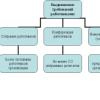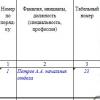How to restore the optic nerve in glaucoma. Treatment of optic nerve atrophy. Physiotherapy treatments
The second pair of cranial nerves is the most important element of the visual system, because the relationship between the retina and the brain is carried out through it. Although the rest of the structures continue to function correctly, any deformations in the neural tissue affect the properties of vision. Atrophy optic nerve does not heal without a trace, nerve fibers cannot be restored to their original state, therefore it is better to carry out prevention on time.
Basic information on the disease
Optic nerve atrophy or optic neuropathy- a severe process of destruction of axons (fibers of nerve tissue). Extensive atrophy thinns the nerve column, healthy tissue is replaced by glial tissue, and small vessels (capillaries) are blocked. Each of the processes causes certain symptoms: visual acuity decreases, various defects appear in the field of vision, and the shade of the optic nerve head (optic nerve disc) changes. All pathologies of the optic nerves account for 2% of the statistics of eye diseases. The main danger of optic neuropathy is absolute blindness, which occurs in 20-25% of people with this diagnosis.
Optical neuropathy does not develop by itself, it is always a consequence of other diseases, so a person with atrophy is examined by different specialists. Usually, optic nerve atrophy is a complication of a missed ophthalmic disease (inflammation in the structures of the eyeball, swelling, compression, damage to the vascular or nervous network).
Causes of optic neuropathy
Despite the many causes of optic nerve atrophy known to medicine, in 20% of cases they remain unclear. Usually these are ophthalmic pathologies, diseases of the central nervous system, autoimmune disruptions, infections, trauma, intoxication. Congenital forms of ADS are often diagnosed together with skull defects (acrocephaly, microcephaly, macrocephaly) and hereditary syndromes.
Causes of optic nerve atrophy on the part of the visual system:
- neuritis;
- obstruction of the artery;
- myopia;
- retinitis;
- oncological lesion of the orbit;
- unstable eye pressure;
- local vasculitis.
Injury to nerve fibers can occur at the time of traumatic brain injury or even the mildest trauma to the facial skeleton. Sometimes optic neuropathy is associated with the growth of meningioma, glioma, neuroma, neurofibroma, and similar formations in the thickness of the brain. Optical disturbances are possible with osteosarcoma and sarcoidosis.
Causes from the central nervous system:
- neoplasms in the pituitary gland or cranial fossa;
- squeezing chiasmata;
- multiple sclerosis.
Atrophic processes in the second pair of cranial nerves often develop as a result of purulent-inflammatory conditions. The main danger is brain abscesses, inflammation of its membranes.

Systemic risk factors
- diabetes;
- atherosclerosis;
- anemia;
- avitaminosis;
- hypertension;
- antiphospholipid syndrome;
- Wegener's granulomatosis;
- systemic lupus erythematosus;
- giant cell arteritis;
- multisystem vasculitis (Behcet's disease);
- nonspecific aortoarteritis (Takayasu's disease).
See also: Danger and prognosis with the optic nerve.
Significant nerve damage is diagnosed after prolonged fasting, severe poisoning, and volumetric blood loss. Alcohol and its surrogates, nicotine, chloroform and some groups of medicines have a negative effect on the structures of the eyeball.
Atrophy of the optic nerve in a child
In half of all cases of optic neuropathy in children, the cause is inflammatory infections of the central nervous system, brain tumors and hydrocephalus. Less often, the state of destruction is due to deformation of the skull, cerebral anomalies, infections (mainly "children"), metabolic disorders. Particular attention should be paid to congenital forms of childhood atrophy. They indicate that the baby has brain diseases that have arisen at the stage of intrauterine development.
Optical neuropathy classification
All forms of optic nerve atrophy are hereditary (congenital) and acquired. Congenital are divided according to the type of inheritance, they often indicate the presence of genetic abnormalities and hereditary syndromes that require in-depth diagnosis.

Hereditary forms of ADS
- Autosomal dominant (juvenile). The predisposition to nerve destruction is transmitted in a heterogeneous way. Usually the disease is detected in children under 15 years of age, it is recognized as the most common, but the mildest form of atrophy. It is always bilateral, although sometimes symptoms appear asymmetrically. Early signs are detected by 2-3 years, and functional disorders only at the age of 6-20. Possible combination with deafness, myopathy, ophthalmoplegia and distortion.
- Autosomal recessive (infantile). This type of ADS is diagnosed less often, but much earlier: immediately after birth or during the first three years of life. The infantile form is bilateral, it is often detected in Kenny-Coffey syndrome, Rosenberg-Chattorian, Jensen or Wolfram disease.
- Mitochondrial (Leber's atrophy). Mitochondrial optic atrophy is the result of a mutation in mitochondrial DNA. This form is ranked among the symptoms of Leber's disease, it occurs suddenly, resembles external neuritis in the acute phase. Most of the patients are men 13-28 years old.
Forms of acquired atrophy
- primary (squeezing of neurons in the peripheral layers, the optic nerve head does not change, the boundaries are clear);
- secondary (swelling and enlargement of the optic nerve disc, blurred boundaries, replacement of axons with neuroglia is quite pronounced);
- glaucomatous (destruction of the ethmoid plate of the sclera due to surges in local pressure).
Destruction is ascending, when the axons of the cranial nerves are affected, and descending, with the involvement of retinal nerve tissues. Symptoms distinguish between unilateral and bilateral ADN, according to the degree of progression - stationary (temporarily stable) and in constant development.
Types of atrophy by optic disc color:
- initial (slight blanching);
- incomplete (noticeable blanching of one segment of the optic disc);
- full (change in shade over the entire area of the optic nerve disc, severe thinning of the nerve pillar, narrowing of the capillaries).
Symptoms of optic nerve atrophy
The degree and nature of optical disorders directly depends on which segment of the nerve is affected. Visual acuity can drop critically very quickly. Complete destruction ends in absolute blindness, blanching of the optic disc with white or gray blotches, narrowing of the capillaries in the fundus. With incomplete ADH, vision stabilizes at a certain time and does not deteriorate anymore, and the blanching of the optic disc is not so pronounced.

If the fibers of the papillomacular bundle are affected, the deterioration of vision will be significant, and the examination will show a pale temporal zone of the optic disc. In this case, optical disturbances cannot be corrected with glasses or even contact lenses. Damage to the lateral zones of the nerve does not always affect vision, which complicates the diagnosis and worsens the prognosis.
ADS is characterized by a variety of visual field defects. The following symptoms allow suspecting optic neuropathy:, concentric narrowing, effect, weak pupil response. In many patients, the perception of colors is distorted, although more often this symptom develops when axons die after neuritis. Often, changes affect the green-red part of the spectrum, but the blue-yellow parts of the spectrum can also be distorted.
Diagnosis of optic nerve atrophy
Expressive clinical picture, physiological changes and functional disorders greatly simplify the diagnosis of ADH. Difficulties can arise when the actual vision does not match the degree of destruction. For an accurate diagnosis, the ophthalmologist must study the patient's history, establish or refute the fact of taking certain drugs, contacts with chemical compounds, injuries, bad habits. Differential diagnosis carried out on the subject of peripheral lens opacity and amblyopia.
Ophthalmoscopy
Standard ophthalmoscopy allows to establish the presence of ADS and to accurately determine the degree of its spread. This procedure is available in many conventional clinics and is inexpensive. The results of the study may differ, however, some signs are detected in any form of neuropathy: a change in the shade and contour of the optic disc, a decrease in the number of vessels, narrowing of the arteries, various defects of the veins.
Ophthalmoscopic picture of optic neuropathy:
- Primary: the clarity of the disc boundaries, the optic disc size is normal or reduced, there is a saucer-like excavation.
- Secondary: a grayish tint, blurred disc boundaries, an increase in the optic nerve disc, no physiological excavation, a parasomal reflex to light sources.

Coherent tomography
Optical coherence or laser scanning tomography allows you to study the nerve disc in more detail. Additionally, the degree of mobility of the eyeballs is assessed, the reaction of the pupils and the corneal reflex is checked, carried out with tables, the defects of the visual field are examined, the color perception is checked, and the eye pressure is measured. The oculist visually determines the presence.
Plain radiography the orbit allows you to identify the pathology of the orbit. Fluorescence angiography shows vasculature dysfunction. Doppler ultrasound is used to study local circulation. If the atrophy is due to an infection, laboratory tests such as an enzyme-linked immunosorbent assay (ELISA) and polymerase chain reaction (PCR) are done.
Electrophysiological tests play a key role in confirming the diagnosis. Atrophy of the optic nerve changes the threshold sensitivity and lability of the nervous tissue. The rapid progression of the disease increases the rates of retino-cortical and cortical time.
The level of reduction depends on the location of the neuropathy:
- when the papillomacular bundle is destroyed, the sensitivity remains at a normal level;
- damage to the periphery causes a sharp increase in sensitivity;
- atrophy of the axial beam does not change the sensitivity, but sharply reduces the lability.
If necessary, check the neurological status (X-ray of the skull, CT or MRI of the brain). When a neoplasm in the brain or unstable intracranial pressure is diagnosed in a patient, a consultation with an experienced neurosurgeon is prescribed. In case of orbital tumors, it is necessary to include in the course of an ophthalmic-oncologist. If the destruction is associated with systemic vasculitis, you need to consult a rheumatologist. Arterial pathologies are dealt with by an ophthalmologist or vascular surgeon.
How is optic atrophy treated?
The treatment regimen for each patient with optic neuropathy is always individual. The doctor needs to get all the information about the disease in order to make an effective plan. People with atrophy require urgent hospitalization, while others are able to support outpatient care. The need for surgery depends on the causes of ADS and symptoms. Any therapy will be ineffective with a weakening of vision to 0.01 units and below.

It is necessary to begin treatment of optic nerve atrophy by identifying and eliminating (or stopping) the root cause. If the cranial nerve injury is due to intracranial tumor growth, aneurysm, or unstable cranial pressure, neurosurgery should be performed. Endocrine factors affect hormonal levels. Post-traumatic compression is surgically corrected by removing foreign bodies, removing chemicals, or limiting hematomas.
Conservative therapy for optic neuropathy is primarily aimed at inhibiting atrophic changes, as well as preserving and restoring vision. Shown are drugs for expanding the vasculature and small vessels, reducing capillary spasm and accelerating blood flow through the arteries. This allows all layers of the optic nerve to be supplied with sufficient nutrients and oxygen.
Vascular therapy for ADN
- intravenously 1 ml of nicotinic acid 1%, glucose for 10-15 days (or orally 0.05 g three times a day after meals);
- one Nikoshpan tablet three times a day;
- intramuscularly 1-2 ml of No-shpy 2% (or 0.04 g orally);
- intramuscularly 1-2 ml of Dibazol 0.5-1% daily (or by mouth at 0.02 g);
- 0.25 g of Nigeksin three times a day;
- subcutaneously, 0.2-0.5-1 ml of sodium nitrate of an ascending concentration of 2-10% in a course of 30 injections (increase every three injections).
Decongestants are needed to reduce swelling, which helps reduce nerve and vascular compression. Anticoagulants are used to prevent thrombosis; the vasodilating and anti-inflammatory Heparin is recognized as the best. It is also possible to prescribe antiplatelet agents (prevention of thrombosis), neuroprotectors (protection of nerve cells), glucocorticosteroids (fight against inflammatory processes).
Conservative treatment of ADS
- To reduce inflammation in the nervous tissue and relieve edema, a dexamethasone solution is prescribed in the eye, intravenous glucose and calcium chloride, and intramuscular diuretics (Furosemide).
- A solution of strychnine nitrate 0.1% in a course of 20-25 subcutaneous injections.
- Parabulbar or retrobulbar injections of Pentoxifylline, Atropine, xanthinol nicotinate. These funds help to accelerate blood flow and improve the trophism of the nervous tissue.
- Biogenic stimulants (FiBS, aloe preparations) in a course of 30 injections.
- Nicotinic acid, sodium iodide 10% or Euphyllin intravenously.
- Vitamins orally or intramuscularly (B1, B2, B6, B12).
- Antioxidants (glutamic acid).
- Oral Cinnarizine, Riboxin, Piracetam, ATP.
- Instillation of Pilocarpine to reduce ocular pressure.
- Nootropic drugs (Lipocerebrin).
- Drugs with antikinin effect (Prodectin, Parmidin) for symptoms of atherosclerosis.
In addition to medications physiotherapy is prescribed. With ADN, oxygen therapy (use of oxygen) and blood transfusion (urgent blood transfusion) are effective. In the recovery process, laser and magnetic procedures are prescribed, electrical stimulation and electrophoresis are effective (administration of drugs using electric current). If there are no contraindications, acupuncture is possible (using needles on active points of the body).

Surgical treatment of optic neuropathy
One of the methods surgical treatment the optic nerve is hemodynamic correction. The procedure can be performed under local anesthesia: a collagen sponge is placed in the sub-Tenon space, which stimulates aseptic inflammation and dilates blood vessels. Thus, it is possible to provoke the proliferation of connective tissue and new vascular network... The sponge dissolves on its own after two months, but the effect lasts for a long time. The operation can be performed several times, but at intervals of several months.
New branches in the vascular network improve the blood supply to nerve tissues, which stops atrophic changes. Correction of blood flow allows you to restore vision by 60% and eliminate up to 75% of visual field defects with a timely visit to the clinic. If the patient has severe concomitant disorders or atrophy has developed to a late stage, even hemodynamic correction will be ineffective.
At partial atrophy optic nerve practice using a collagen implant. It is impregnated with antioxidants or drugs to expand capillaries, and then injected into eyeball without seams. This method is only effective when the eye pressure is stable. The operation is contraindicated in patients over 75 years old, with diabetes mellitus, severe somatic disorders and inflammation, as well as vision less than 0.02 diopters.
Prognosis for optic nerve atrophy
To prevent ADH, it is necessary to regularly check the state of those organs that regulate the functioning of the visual system (central nervous system, endocrine glands, joints, connective tissue). In a severe case of infection or intoxication, as well as in severe bleeding, urgent symptomatic therapy should be carried out.
It is impossible to completely regain your vision after neuropathy even in the best clinic. A successful case is when the patient's condition has stabilized, ADS does not progress for a long time, and vision is partially restored. For many people, visual acuity remains permanently impaired, and there are also defects in lateral vision.
Some forms of atrophy continue to progress even with adequate treatment. The ophthalmologist's task is to slow down atrophic and other negative processes. Having stabilized the symptoms, it is necessary to constantly carry out the prevention of ischemia and neurodegeneration. For this, long-term supportive therapy is prescribed, which helps to improve the lipid profile of the blood and prevent the formation of blood clots.
The course of treatment for optic nerve atrophy must be repeated regularly. It is very important to eliminate all factors that can affect the axons of the optic nerve. A patient with optic neuropathy should have regular specialist appointments as indicated. It is necessary to constantly carry out the prevention of complications and improve the way of life. Refusal of therapy for optic neuropathy inevitably leads to disability due to total death of nerves and irreversible blindness.
Any changes in the layers of the optic nerve negatively affect a person's ability to see. Therefore, it is necessary to undergo examinations in time for people with a predisposition and treat all diseases that contribute to atrophy of the optic nerve. Therapy will not help restore vision to 100% when optic neuropathy is already well developed.
It is possible to restore the optic nerve in glaucoma with medication and non-medication. It all depends on the degree of damage and the duration of the pathological process. If the disease is in the initial stages, a small therapeutic course is sufficient. When is the return of adequate functionality visual organ becomes impossible, nerve excavation is recommended.
Causes of pathology
The optic nerve is made up of tiny cells - neurons and their fibers - dendrites and axons. All of them, through the synaptic clefts and the mediator acetylcholine, which circulates in them, transmit information from the outside world and transform it into visual images. The latter enter the parietal cortex of the occipital regions of the brain, where a holistic picture of the world is formed.
Glaucoma is characterized by an increase in intraocular pressure, resulting in atrophy of rods and cones, resulting in complete blindness.
Symptoms of damage to the optic nerve
This disease is determined by the following clinical symptoms:
- The formation of rainbow circles around light sources. They form in the form of a rainbow next to lanterns, car headlights, light bulbs, or computer monitors.
- Periodic. lacrimation. It is defensive reaction through which the eye tries to compensate for the lost functions.
- Painful sensations and the illusion of having foreign body in the conjunctival sac. Such symptoms appear during the inflammatory process.
- Deterioration of visual function in one or both eyes. They can range from mild dysfunction to severe amorosis.
Is it possible to recover?
Atrophy of rods and cones can be restored with early detection of pathology; otherwise, regeneration is impossible.
Regeneration of the optic nerves with a persistent increase in intraocular pressure is possible only when the pathology is detected in the early stages. Neurocytes do not recover if prolonged hypoxia due to increased intraocular pressure affects them chronically. If the ophthalmologist timely established dangerous processes, appointed effective diagnosis and carried out adequate treatment, the regenerative abilities of rods and cones are increased.
Therapies
Restoration of the optic nerve is performed with the help of medications, laser correction and physiotherapy techniques. If the process has gone too far, doctors recommend removing the optic nerve so that purulent processes that threaten meningitis and encephalitis do not appear in the orbital area.
Ophthalmic drugs
Medicines containing blueberry anthocyanins effectively help restore vision. It is also recommended to use injections and tablets with retinol and vitamin A. This biologically active substance effectively restores ophthalmic functions, integrating into mediator substances, and also forming visual pigment. Also useful are medicines containing components that optimize the microcirculation of the retina and conjunctiva. When blood flow, red blood cells that are filled with oxygen, increases, regeneration becomes more effective.
Laser treatment of the optic nerve shows good results, but the operation is expensive.
For the treatment of dysfunctions, the latest technique is also carried out using a device based on a laser. The laser beam affects the areas of the optic nerve in those locations where ischemia has occurred. This technique is relatively expensive, but it effectively eliminates the dysfunctions that have appeared and is practically painless in the absence of severe side effects... The method is performed under local anesthesia.
Atrophy of the optic nerve is characterized by the development of the process of complete or partial death of nerve fibers, accompanied by the replacement of healthy connective tissues.
Disease types
Atrophy of the optic nerve head, depending on its etiology, is divided into several types. These include:
- Primary form (ascending and descending optic nerve atrophy). This pathological process develops as an independent disease. The descending type is diagnosed much more often than the ascending one. This disease is usually observed in males, since it is linked only to the X chromosome. The first manifestations of the disease occur at about 15-25 years. In this case, the damage directly to the nerve fibers occurs.
- Secondary atrophy of the optic nerve. In this case, the pathological process develops against the background of other diseases. In addition, the violation may be due to a failure in the flow of blood to the nerve. A disease of this nature can appear in any person, regardless of his age and gender.

By the nature of the course, the following types of this disease are distinguished:
- Partial atrophy of the optic nerve (initial). The main difference between this type is the partial preservation of visual ability, which is most important with impaired vision (due to which wearing glasses or contact lenses not able to improve the quality of vision). Despite the fact that the residual visual ability, as a rule, lends itself to preservation, there are often failures in color perception. Those portions of the fields of view that have been saved will still remain available.
- Complete atrophy of the optic nerve. In this case, the symptomatology of the disease has some similarities with such eye pathologies as cataract and amblyopia. In addition, this type of disease can manifest itself in a non-progressive form that does not have specific symptoms. This fact indicates that the state of the necessary visual functions remains stable. However, most often there is a progressive form of pathology, during which there is a rapid loss of vision, which, as a rule, cannot be restored. This greatly complicates the diagnostic process.

Symptoms
If atrophy of the optic nerve develops, symptoms appear mainly in the form of deterioration in the quality of vision at the same time in both eyes or in only one. Restoration of visual ability in this case is impossible. Depending on the type of pathology, this symptom can have a different manifestation.
With the progression of the disease, vision gradually deteriorates. In the most severe cases, there is a complete atrophy of the optic nerve, which provokes a complete loss of the ability to see. This process can last for many weeks, or it can develop in a couple of days.

If there is partial atrophy of the optic nerve, there is a gradual slowdown in progression, after which it completely freezes at a certain stage. At the same time, visual activity ceases to decrease.
Signs of optic nerve atrophy often appear as. They usually narrow, which is characterized by loss of lateral vision. This symptom can be almost imperceptible, but sometimes there is tunnel vision, that is, when the patient is able to see only those objects that are localized directly in the direction of his gaze, as if through a thin tube. Very often, with atrophy, dark, light or colored spots appear in front of the eyes, and it becomes difficult for a person to distinguish colors.
The appearance of dark or white spots in front of the eyes (both when closed and open) suggests that the process of destruction affects nerve fibers that are located in the central part of the retina or very close to it. The narrowing of the visual fields begins if peripheral nerve tissues were affected.
With a more extensive spread of the pathological process, most of the visual field may disappear. This type of disease can spread to only one eye or affect both at once.
Causes of occurrence
The causes of optic nerve atrophy can be different. Both acquired diseases and congenital ones, which are directly related to the visual organs, act as a provoking factor.

The appearance of atrophy can be triggered by the development of diseases that directly affect the nerve fibers or the retina of the eye. The following pathological processes can be cited as examples:
- mechanical damage (burn or injury) to the retina;
- inflammatory processes;
- dystrophy of the optic nerve (optic nerve disc) of a congenital nature;
- stagnant fluid and swelling;
- toxic effects of certain chemicals;
- violation of blood access to nerve tissues;
- squeezing certain areas of the nerve.
In addition, diseases of the nervous and other systems of the body play an important role in the development of this pathological process.

Quite often, the onset of this pathological is due to the development of diseases that directly affect the central nervous system of a person. It can be;
- syphilitic brain damage;
- the development of abscesses;
- neoplasms of a different nature in the brain;
- meningitis;
- encephalitis;
- mechanical damage to the skull;
- the development of multiple sclerosis.
More rare causes are alcohol poisoning of the body and intoxication with other chemicals.
Sometimes this pathology develops against the background of hypertension or atherosclerosis, as well as others cardiovascular disease... In rare cases, the cause may be a lack of vitamins and macronutrients in the human body.
In addition to the listed reasons, obstruction of the central or peripheral retinal arteries can affect the development of atrophic disorders. This is because these arteries provide the body with nutrients. As a result of their blockage, the metabolism is disturbed, which provokes a deterioration in the general condition. Quite often, obstruction is a consequence of the development of glaucoma.
Diagnostics
During the examination of the patient, the doctor must necessarily identify the presence of concomitant diseases, the fact of using certain medications and contact with caustic substances, the presence of bad habits and symptoms indicating the development of intracranial disorders.
In most cases, the diagnosis of diseases of this nature does not cause great difficulties. In order to determine an accurate diagnosis, it is necessary first of all to check the quality of visual function, namely to determine the acuity and fields of vision and conduct tests for color perception. This is followed by ophthalmoscopy. This procedure allows you to identify the pallor of the optic nerve disk and a decrease in the lumen of the vessels of the fundus, characteristic of such a disease. Another mandatory procedure is.

Very often, diagnostics involves the use of the following instrumental methods:
- X-ray examination;
- magnetic resonance imaging (MRI);
- computed tomography of the brain;
- electrophysiological diagnostics;
- contrast methods (used to determine the patency of the retinal vessels).
Laboratory methods of diagnostics are carried out without fail, in particular, general and biochemical blood tests.
Treatment methods
Treatment for optic nerve atrophy should be carried out immediately after the diagnosis is made. It should be remembered that it is impossible to completely get rid of the disease, however, it is quite possible to slow down its progression and even stop it.

During therapy, it is necessary to take into account the fact that this pathological process is not an independent disease, but the result of diseases affecting one or another part of the visual organ. Therefore, in order to cure the atrophy of the optic nerve, it is necessary first of all to eliminate the provoking factor.
In most cases, complex therapy is used, involving the use of drugs and optical surgery. Treatment can be carried out with the following medications:
- vasodilators(Papaverine, Dibazol, Sermion);
- anticoagulants (Heparin);
- drugs that improve metabolism (aloe extract);
- vitamin complexes;
- enzyme preparations (Lidaza, Fibrinolysin);
- agents that increase immunity (extract of Eleutherococcus);
- hormonal anti-inflammatory drugs (dexamethasone);
- drugs that improve the functioning of the central nervous system (Nootropil, Emoxipin).

The listed drugs can be used in the form of tablets, solutions, eye drops and injection. In the most severe cases, surgery is needed. Many are interested in whether such a disease can be cured only by conservative methods. Sometimes this is possible, but only a specialist can answer the question of how to treat atrophy in a particular case.
Any medicine should be taken only after the appointment of the attending physician, observing the prescribed dosage. It is strictly forbidden to choose drugs on your own.
Quite often, during the treatment of optic nerve atrophy, physiotherapy procedures are carried out. Acupuncture or laser and magnetic stimulation of the optic nerve are especially effective.
Treatment can be used in some cases folk remedies... Various infusions and decoctions are used to restore the optic nerve. medicinal plants... However, this method can only be used as an additional therapy in combination with traditional medicine and only after consulting your doctor.
Surgery is usually prescribed in the presence of neoplasms of a different nature and hereditary atrophy of the optic nerve. Surgery is required if there are congenital malformations of the optic organ, such as Leber's optic atrophy.
Currently, with atrophy of Leber's optic nerves and other congenital disorders, the following surgical methods are used:
- extrascleral methods (the most common type of surgical intervention for eye pathologies);
- vasoconstructive therapy;
- decompression methods (used very rarely).
With this pathology, symptoms and treatment are interrelated, since the doctor prescribes therapy depending on the symptoms and the type of disease that manifests itself.

In order not to risk your eyesight, self-medication is strictly prohibited. At the first symptoms of a violation, it is recommended to seek medical attention from a doctor. In this case, you should find a suitable clinic where you can cure the disease most effectively.
Forecast and prevention
Timely detection of complete or partial atrophy of the optic nerve and its treatment can prevent the development of destructive tissue disorders. Properly prescribed therapy will help maintain the quality of visual function, and sometimes even improve it. However, it is impossible to achieve complete restoration of vision due to severe damage and death of nerve fibers.

Lack of timely treatment can provoke very serious complications that lead not only to a decrease in vision, but also to its complete loss. In this case, the prognosis is disappointing, since it will no longer be possible to restore visual ability.
In order to prevent the development of this pathological process, the following rules must be observed:
- engage in prevention and timely treatment any infectious and inflammatory diseases of the body;
- avoid mechanical damage to the eye tissue and brain injury;
- periodically undergo examination by a doctor and carry out all the necessary diagnostic measures for early detection of diseases;
- quit smoking;
- remove alcoholic beverages from life;
- measure blood pressure regularly;
- adhere to proper nutrition;
- to live an active lifestyle;
- arrange regular walks in the fresh air.

A disease of this nature is very serious, therefore, at the first symptoms, it is imperative to consult a specialist and in no case self-medicate.
Video
Atrophy of the optic nerve is called the complete or partial destruction of its fibers with their replacement connective tissue.

Causes of optic nerve atrophy
The causes of visual atrophy include heredity and congenital pathology; it may be a consequence various diseases eyes, pathological processes in the retina and optic nerve (inflammation, dystrophy, trauma, toxic damage, edema, congestion, various circulatory disorders, compression of the optic nerve, etc.), pathology nervous system or with common diseases.
More often, atrophy of the optic nerve develops as a result of the pathology of the central nervous system (tumors, syphilitic lesions, brain abscesses, encephalitis, meningitis, multiple sclerosis, skull injuries), intoxication, alcohol poisoning with methyl alcohol, etc.
Also, the reasons for the development of optic nerve atrophy can be hypertension, atherosclerosis, quinine poisoning, vitamin deficiency, starvation, profuse bleeding.
Atrophy of the optic nerve appears as a result of obstruction of the central and peripheral retinal arteries supplying the optic nerve, and it is also the main symptom of glaucoma.
Symptoms of optic nerve atrophy
There are primary and secondary atrophy of the optic nerves, partial and complete, complete and progressive, unilateral and bilateral.
The main symptom of optic nerve atrophy is a decrease in visual acuity that cannot be corrected. Depending on the type of atrophy, this symptom manifests itself in different ways. So, with the progression of atrophy, vision gradually decreases, which can lead to complete atrophy of the optic nerve and, accordingly, to complete loss of vision. This process can take from several days to several months.
With partial atrophy, the process stops at some stage and vision ceases to deteriorate. Thus, progressive atrophy of the optic nerves and complete atrophy are distinguished.
Visual impairment in atrophy can be very diverse. This can be a change in the visual fields (more often narrowing, when “peripheral vision” disappears), up to the development of “tunnel vision”, when a person looks as if through a tube, i.e. sees objects that are only directly in front of him, while scotomas often appear, i.e. dark spots anywhere in the field of view; it can be a color vision disorder.
Changes in visual fields can be not only "tunnel", it depends on the localization of the pathological process. So, the appearance of cattle (dark spots) right in front of the eyes indicates damage to nerve fibers closer to the central or directly in the central part of the retina, narrowing of the visual fields occurs due to damage to peripheral nerve fibers, with deeper lesions of the optic nerve, half of the visual field (or temporal , or nasal). These changes can be in one or both eyes.
Examination for suspected optic atrophy
It is unacceptable to engage in self-diagnosis and self-medication with this pathology, because something similar happens with peripheral cataract, when lateral vision is first disturbed, and then the central sections are involved. Also, atrophy of the optic nerves can be confused with amblyopia, in which vision can also be significantly reduced and not amenable to correction. It is worth noting that the above pathology is not as dangerous as optic nerve atrophy. Atrophy can be not only an independent disease or a consequence of some local pathology in the eye, but also a symptom of a serious and sometimes fatal disease of the nervous system, therefore it is very important to establish the cause of optic nerve atrophy as early as possible.
If you experience similar symptoms, you should immediately contact an ophthalmologist and neurologist. These two specialists have a major role in the treatment of this disease. There is also a separate branch of medicine - neuro-ophthalmology, doctors - neuro-ophthalmologists, who are engaged in the diagnosis and treatment of such a pathology. If necessary, neurosurgeons, therapists, otorhinolaryngologists, infectious disease specialists, oncologists, toxicologists, etc. can also take part in the diagnosis and treatment.
Diagnosis of optic nerve atrophy is usually straightforward. It is based on the determination of acuity and visual fields (perimetry), on the study of color perception. The ophthalmologist necessarily conducts an ophthalmoscopy, in which he reveals the blanching of the optic nerve head, narrowing of the vessels of the fundus and measures intraocular pressure... A change in the contours of the optic nerve head indicates the primary or secondary nature of the disease, i.e. if its contours are clear, then, most likely, the disease has developed for no apparent reason, if the contours are blurred, then perhaps it is post-inflammatory or post-congestive atrophy.
If necessary, an X-ray examination (craniography with a mandatory image of the Turkish saddle area), computed or magnetic resonance imaging of the brain, electrophysiological research methods and fluorescent-angiographic methods are performed, in which the patency of the retinal vessels is checked using a special substance administered intravenously.
Laboratory research methods can also be informative: general analysis blood, biochemical analysis blood test, a test for syphilis or borrelliasis.
Treatment of optic nerve atrophy
Treatment of optic nerve atrophy is a very difficult task for doctors. It is necessary to know that the damaged nerve fibers cannot be restored. One can hope for some effect from the treatment only when the functioning of the nerve fibers that are in the process of destruction, which have still retained their vital activity, is restored. If this moment is missed, then the vision on the sore eye can be lost forever.
When treating atrophy, it must be borne in mind that it is often not an independent disease, but a consequence of other pathological processes affecting various parts of the visual pathway. Therefore, the treatment of optic nerve atrophy must be combined with the elimination of the cause that caused it. In the case of timely elimination of the cause and, if the atrophy has not yet developed, within 2-3 weeks to 1-2 months, the picture of the fundus is normalized and visual functions are restored.
Treatment is aimed at eliminating edema and inflammation in the optic nerve, improving its blood circulation and trophism (nutrition), restoring the conduction of not completely destroyed nerve fibers.
But it should be noted that the treatment of optic nerve atrophy is long-term, the effect of it is weak, and sometimes completely absent, especially in advanced cases. Therefore, it should start as early as possible.
As mentioned above, the main thing is the treatment of the underlying disease, against which the complex treatment directly atrophy of the optic nerve. For this, various forms of drugs are prescribed: eye drops, injections, both general and local; tablets, electrophoresis. Treatment is aimed at
- improvement of blood circulation in the vessels feeding the nerve - vasodilators (complamin, nicotinic acid, no-shpa, papaverine, dibazol, euphyllin, trental, halidor, sermion), anticoagulants (heparin, tiklid);
- to improve metabolic processes in the nerve tissue and stimulating the restoration of altered tissue - biogenic stimulants (aloe extract, peat, vitreous and others), vitamins (ascorutin, B1, B2, B6), enzymes (fibrinolysin, lidase), amino acids (glutamic acid), immunostimulants (ginseng, eleuthorococcus);
- for resorption of pathological processes and stimulation of metabolism (phosphaden, preductal, pyrogenal); for relief inflammatory process - hormonal drugs(prednisolone, dexamethasone); to improve the functioning of the central nervous system (emoxipin, cerebrolysin, fezam, nootropil, cavinton).
Drugs must be taken as directed by a physician after diagnosis. The doctor will select the optimal treatment, taking into account the concomitant diseases. In the absence of concomitant somatic pathology, you can independently take no-shpa, papaverine, vitamin preparations, amino acids, emoxipin, nootropil, fezam.
But self-medication for this serious pathology should not be dealt with. Also used physiotherapy, acupuncture; methods of magnetic, laser and electrical stimulation of the optic nerve have been developed.
The course of treatment is repeated after a few months.
Nutrition for optic atrophy should be complete, varied and rich in vitamins. You need to eat as much as possible fresh vegetables and fruits, meat, liver, dairy products, cereals, etc.
With a significant decrease in vision, the issue of assigning a disability group is resolved.
The visually impaired and the blind are assigned a rehabilitation course aimed at eliminating or compensating for the disabilities that have arisen as a result of loss of vision.
Treatment with folk remedies is dangerous because precious time is lost, when it is still possible to cure atrophy and restore vision. It should be noted that with this disease, folk remedies are ineffective.
Complications of optic nerve atrophy
The diagnosis of optic nerve atrophy is very serious. At the slightest decrease in vision, you must immediately consult a doctor so as not to miss your chance for recovery. In the absence of treatment and with the progression of the disease, vision may disappear completely, and it will no longer be possible to restore it. In addition, it is very important to identify the cause of the optic nerve atrophy, and eliminate it as soon as possible, because this can be fraught with not only loss of vision, but also deadly.
Prevention of optic nerve atrophy
In order to reduce the risk of optic nerve atrophy, it is necessary to promptly treat diseases leading to atrophy, prevent intoxication, conduct blood transfusions with profuse bleeding and, of course, consult a doctor in a timely manner at the slightest sign of visual impairment.
Doctor ophthalmologist Odnoochko E.A.

Atrophy of the optic nerve is a disease in which there is a decrease in vision, sometimes to its complete loss. This happens when the nerve fibers that carry information about what a person sees from the retina to the visual section of the brain die off partially or completely. Such a pathology can arise due to many reasons, because a person can face it at any age.
Important! Timely detection and treatment of the disease, if the death of the nerve is partial, helps to stop the loss of visual function and restore it. If the nerve has completely atrophied, then vision cannot be restored.
The optic nerve is an afferent nerve fiber that runs from the retina to the occipital visual region of the brain. Thanks to this nerve, information about visible to humans the picture, and is transmitted to the visual department, and in it it is already transformed into a familiar image. When atrophy occurs, nerve fibers begin to die off and be replaced by connective tissue, which is similar to scar tissue. In this condition, the functioning of the capillaries that feed the nerve stops.
How is the disease classified
By the time of occurrence, there is congenital and acquired atrophy of the optic nerve. By localization, the pathology can be:
- ascending - the layer of nerve fibers located on the retina of the eye is affected, and the lesion itself is sent to the brain;
- descending - the visual part of the brain is affected, and the lesion is directed to the disc on the retina.

Depending on the degree of the lesion, atrophy can be:
- initial - only some fibers are affected;
- partial - the diameter of the nerve is affected;
- incomplete - the lesion is widespread, but vision is not completely lost;
- complete - the optic nerve dies, leading to a complete loss of visual function.
With a unilateral disease, one nerve is damaged, as a result of which one eye begins to see poorly. When the nerves of both eyes are damaged, they speak of bilateral atrophy. According to the stability of visual function, pathology can be stationary, in which visual acuity falls and then remains at the same level and progressive when vision becomes worse and worse.
Why the optic nerve can atrophy

The causes of optic atrophy are varied. The congenital form of the disease in children occurs due to genetic pathologies such as Leber's disease. In this case, partial atrophy of the optic nerve most often occurs. The acquired form of pathology occurs due to various diseases of a systemic and ophthalmological nature. The death of a nerve can occur due to:
- compression of the vessels feeding the nerve or the nerve itself by a neoplasm in the skull;
- myopia;
- atherosclerosis, leading to plaque in the vessels;
- thrombosis of nerve vessels; v
- inflammation of the vascular walls during syphilis or vasculitis;
- violations of the structure of blood vessels due diabetes mellitus or raising blood pressure;
- eye injury;
- intoxication of the body during respiratory viral infections, with the use of large doses of alcohol, drugs or due to excessive smoking.
The ascending form of the disease occurs when eye diseases such as glaucoma and myopia. Causes of descending optic nerve atrophy:
- retrobulbar neuritis;
- traumatic damage to the place where the optic nerves intersect;
- neoplasm in the pituitary gland of the brain.
One-sided disease occurs due to diseases of the eyes or eye sockets, as well as from initial stage cranial diseases. Both eyes at once can suffer from atrophy due to:
- intoxication;
- syphilis;
- neoplasms in the skull;
- poor blood circulation in the vessels of the nerve during atherosclerosis, diabetes mellitus, hypertension.
What is the clinical picture of the disease
Symptoms of optic atrophy depend on the form of the disease. When this disease occurs, vision cannot be corrected with glasses. The most basic symptom is decreased visual acuity. The second symptom is a change in the fields of visual function. On this basis, the doctor can understand how deeply the lesion has arisen.

The patient develops "tunnel vision", that is, the person sees as he would see by attaching a tube to the eye. Peripheral (lateral) vision is lost and the patient sees only those objects that are directly in front of him. In most cases, this vision is accompanied by scotomas - dark spots anywhere in the field of vision. Later, a disorder of color perception begins, the patient first ceases to distinguish green, then red.
With damage to nerve fibers concentrated as close as possible to the retina or directly in it, dark spots appear in the center of the visible image. With a deeper lesion, half of the image from the side of the nose or temple may disappear, depending on which side the lesion occurred on. With secondary atrophy, which has arisen due to any ophthalmic disease, the following symptoms occur:
- the veins of the eyes expand;
- the vessels are narrowed;
- the boundaries of the optic nerve area become smoothed;
- the retinal disc turns pale.
Important! If even a slight cloudiness appears in the eye (or both eyes), you should visit an ophthalmologist as soon as possible. Only by detecting the disease in time, it is possible to stop it at the stage of partial atrophy and restore vision without allowing complete atrophy.
What are the features of pathology in children
With the congenital form of the disease, it can be determined that the pupils of the baby do not react well to light. When a child grows up, parents may notice that he does not respond to an object brought to him from some specific side.
Important! A child under two or three years old cannot report that he sees poorly, and older children, whose problem is congenital, may not realize that they can see somehow differently. That is why it is necessary that the child be examined by an ophthalmologist annually, even if there are no symptoms visible to the parent.

Parents should take the child to the doctor if he rubs his eyes or unconsciously tilts his head to one side, trying to examine something. Forced tilt of the head to some extent compensates for the function of the affected nerve and slightly sharpens vision. The main clinical picture of optic nerve atrophy in a child is the same as in an adult.
If diagnostics and treatment are carried out in a timely manner, provided that the disease is not genetic, during which nerve fibers are completely replaced by fibrous tissue even during intrauterine development, then the prognosis for restoration of the optic nerve in babies is more favorable than in adult patients.
How is the disease diagnosed?
Diagnosis of optic nerve atrophy is carried out by an ophthalmologist, and primarily includes an examination of the fundus and determination of visual fields using computerized peripetry. It also determines what colors the patient can distinguish. TO instrumental methods diagnosis include:

- X-ray of the skull;
- Magnetic resonance imaging;
- angiography of the vessels of the eye;
- video ophthalmological examination;
- Ultrasound of the vessels of the head.
Thanks to these studies, it is possible not only to identify the death of the optic nerve, but also to understand why it happened. You may also need to consult related specialists.
How is optic atrophy treated?
How to treat optic nerve atrophy should be decided by the doctor on the basis of the research. It should be noted right away that the treatment of this disease is very difficult, because nerve tissues are very poorly regenerated. It is necessary to carry out complex systematic therapy, which should take into account the cause of the pathology, its prescription, the patient's age, and his general state... If a process that takes place inside the skull (for example, a tumor or inflammation) has led to the death of a nerve, then the neurosurgeon and neuropathologist should begin the treatment.
Medication treatment
With the help of drugs, you can increase blood circulation and nerve trophism, as well as stimulate the vital activity of healthy nerve fibers. Medication includes taking:

- vasodilator drugs - No-Shpy and Dibazol;
- vitamin B;
- biogenic stimulants, for example, aloe extract;
- drugs that improve microcirculation, such as Eufillin and Trental;
- steroid anti-inflammatory drugs - Hydrocortisone and Dexamethasone;
- antibacterial drugs, ate atrophy has an infectious and bacterial pathogenesis.
In addition, physical therapy may be required to stimulate the optic nerve, such as laser stimulation, magnetic therapy, or electrophoresis.

Microsurgical treatment is aimed at eliminating compression of the nerve, as well as increasing the diameter of the vessels that feed it. Conditions can also be created in which new vessels can grow. Surgery can only help with partial atrophy, if the nerves die off completely, then even through surgery it is impossible to restore visual function.
Treatment with folk remedies
Treatment of optic nerve atrophy with folk remedies is permissible only at the initial stage of the disease, but it is not aimed at improving vision, but at eliminating the root cause of the disease.
Important! Self-medication without prior medical advice can only aggravate the situation and lead to irreversible consequences.
If the disease is caused by high blood pressure, then plants with hypotensive properties are used in therapy:
- astragalus woolly-flowered;
- lesser periwinkle;
- hawthorn (flowers and fruits);
- chokeberry;
- Baikal skullcap (root);
- Daurian black cohosh;
- large-flowered magnolia (leaves);
- marsh dryweed.

Blueberries are useful for vision, they contain many vitamins, as well as anthocyanoside, which has a positive effect on the visual apparatus. For treatment, it is necessary to mix one kilogram of fresh berries with one and a half kilograms of sugar and refrigerate. Such a mixture is taken in half a glass for a month. The course must be repeated twice a year, which will be beneficial even with good eyesight.
If in mesh shell eyes, dystrophic processes occur, especially those occurring against a background of low blood pressure, then tinctures will be useful, for the preparation of which are used:
- leaves of Chinese lemongrass;
- roots of enticement;
- leuzea;
- ginseng;
- eleutherococcus;
- sea buckthorn (fruits and pollen).

If there is incomplete necrosis of the nerves or senile degenerative changes in the eyes occur, then it is necessary to take anti-sclerotic plants:
- Orange;
- Cherry;
- hawthorn;
- cabbage;
- corn;
- seaweed;
- dandelion;
- chokeberry;
- garlic and onions.
Carrots (contains a lot of carotene) and beets (rich in zinc) have beneficial properties.
What is the prognosis for optic nerve atrophy and its prevention
When diagnosing and starting therapy for early stage development, it is possible to maintain and even slightly improve visual acuity, as well as expand its fields. No treatment can fully restore visual function. If the disease progresses, and there is no treatment, then this leads to disability due to complete blindness.
In order to prevent necrosis of nerve fibers, it is necessary to undergo timely treatment of ophthalmic diseases, as well as diseases of an endocrine, neurological, infectious and rheumatological nature. Very important in prevention is the prevention of intoxication of the body.



















